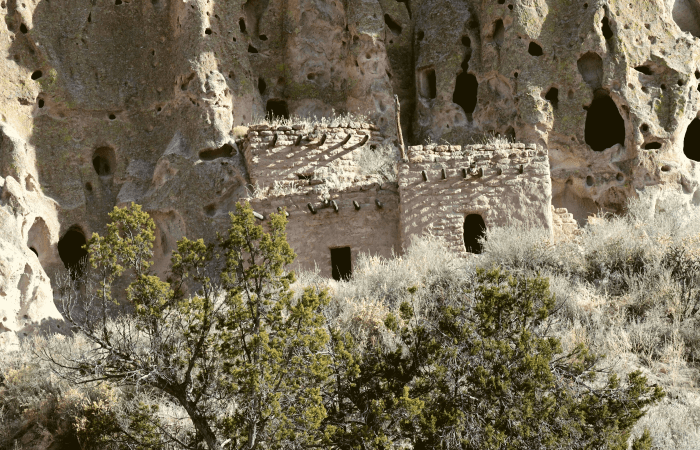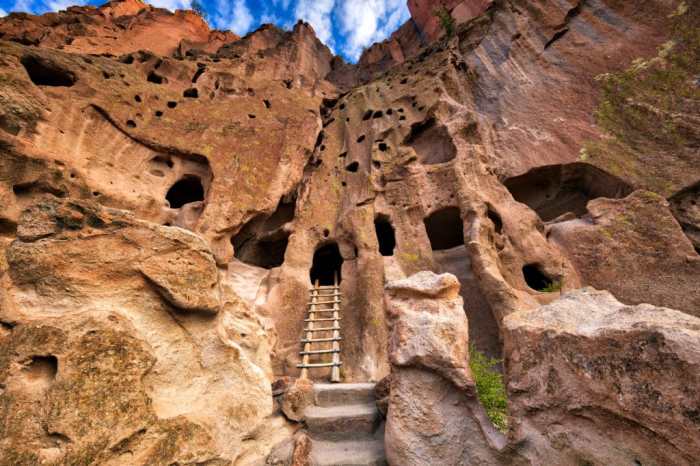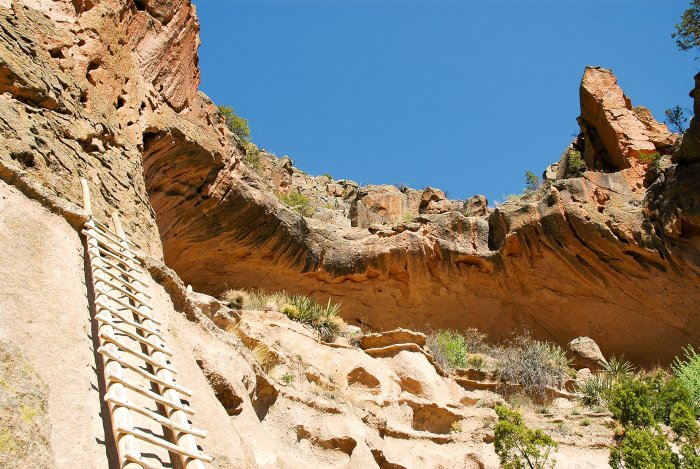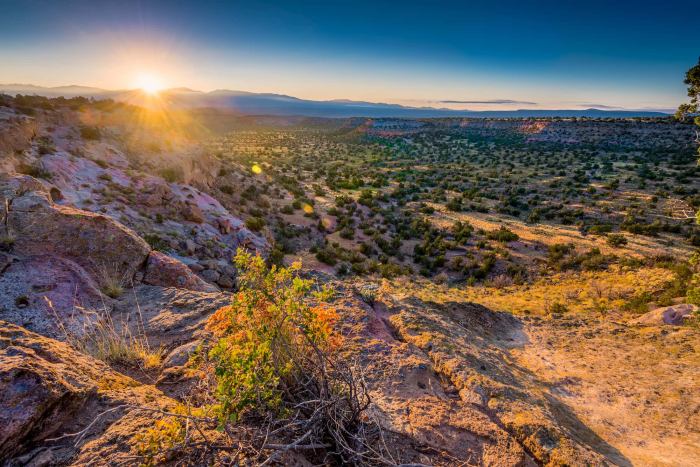Bandelier National Monument stands as a testament to the enduring legacy of human history and the vibrant tapestry of nature. Within its boundaries, visitors embark on a captivating journey that intertwines the rich cultural heritage of the Puebloan people with the breathtaking beauty of the southwestern landscape.
From towering cliffs and ancient petroglyphs to diverse ecosystems and abundant wildlife, Bandelier National Monument offers a sanctuary for exploration, discovery, and the preservation of our collective past and present.
Bandelier National Monument’s Significance

Bandelier National Monument, nestled in the heart of New Mexico, stands as a testament to the rich cultural heritage of the American Southwest. Established in 1916, the monument encompasses over 33,000 acres of rugged terrain, dotted with ancient dwellings, archaeological sites, and breathtaking natural beauty.
Bandelier’s cultural significance is deeply intertwined with the ancestral Puebloan people who inhabited the region for centuries. Their remarkable architectural achievements, including the iconic cliff dwellings carved into the soft volcanic tuff, offer a glimpse into their sophisticated society and way of life.
Bandelier National Monument, with its breathtaking cliffs and ancient petroglyphs, offers a glimpse into the rich cultural heritage of the American Southwest. Just as the abbotsford convent preserves the legacy of Victorian architecture in Australia, Bandelier National Monument safeguards the ancestral traditions and geological wonders of the Puebloan people.
Its well-preserved cliff dwellings and petroglyphs provide a unique opportunity to connect with the past and appreciate the enduring legacy of human history.
UNESCO World Heritage Site
In recognition of its exceptional cultural and natural value, Bandelier National Monument was designated a UNESCO World Heritage Site in 1992. This prestigious designation underscores the monument’s global importance and the need to preserve its cultural heritage for future generations.
Preservation and Protection, Bandelier national monument
The National Park Service, the custodian of Bandelier National Monument, plays a vital role in preserving and protecting the monument’s cultural resources. Through meticulous research, conservation efforts, and visitor education programs, the park service ensures that the legacy of the ancestral Puebloan people remains intact for generations to come.
Geological and Ecological Features

Bandelier National Monument is renowned for its stunning geological formations and ecological diversity. Its unique landscapes have been shaped by volcanic activity, erosion, and the Rio Grande River.
Geological Formations
The monument encompasses a diverse array of geological formations, including towering cliffs, deep canyons, and volcanic mesas. The most prominent feature is the 14-mile-long Frijoles Canyon, which was carved by the Rio Grande over millions of years. The canyon walls are adorned with stunning volcanic tuff and ash deposits, creating a vibrant and colorful landscape.
Ecological Diversity
Bandelier National Monument supports a wide range of plant and animal life. The vegetation varies from desert scrub at the lower elevations to ponderosa pine forests at higher altitudes. The monument is home to over 700 species of plants, including piñon pine, juniper, and various wildflowers.
The monument also provides habitat for a diverse array of wildlife. Mammals include black bears, bobcats, coyotes, and elk. Over 200 species of birds have been recorded, including golden eagles, peregrine falcons, and ravens. The Rio Grande provides a vital water source for many species, including fish, amphibians, and reptiles.
Conservation Efforts
Bandelier National Monument plays a crucial role in protecting endangered species. The monument provides habitat for the Jemez Mountain salamander, a federally threatened species found only in the Jemez Mountains. The monument also supports populations of the Mexican spotted owl, a federally endangered species.
The National Park Service implements various conservation measures to protect the monument’s ecosystems and endangered species. These measures include habitat restoration, wildlife monitoring, and invasive species management. The monument’s conservation efforts ensure that future generations can continue to enjoy the beauty and diversity of Bandelier National Monument.
Cultural Heritage and Ancestral History

Bandelier National Monument preserves a rich tapestry of cultural heritage, spanning thousands of years of human habitation. The region’s ancestral history is predominantly shaped by the Puebloan peoples, who left an enduring legacy through their settlements, artifacts, and cultural traditions.
The Puebloan people, known for their skilled craftsmanship and sophisticated agricultural practices, inhabited the area from approximately the 13th to 16th centuries. They established numerous settlements within the monument, including the iconic cliff dwellings of Alcova House and Tsankawi.
Cultural Traditions and Beliefs
The Puebloan people possessed a complex and vibrant culture. They practiced a sophisticated form of agriculture, utilizing irrigation systems and cultivating a variety of crops. They also engaged in pottery making, weaving, and other crafts, creating intricate and beautiful objects.
The Puebloan people held a deep reverence for nature and the spirits that inhabited it. Their spiritual beliefs centered around the concept of a harmonious balance between humans and the environment.
Preservation and Interpretation
Bandelier National Monument is dedicated to preserving and interpreting the cultural heritage of the Puebloan people. The park’s visitor center and museum house a collection of artifacts and exhibits that provide insights into the lives and traditions of the ancient inhabitants.
Ranger-led tours and interpretive programs offer visitors the opportunity to explore the monument’s archaeological sites and learn about the history and culture of the Puebloan people.
Visitor Experience and Recreational Opportunities

Bandelier National Monument offers a wide range of recreational activities for visitors to enjoy the breathtaking scenery, rich cultural heritage, and diverse ecosystem of the region.
Whether you’re an avid hiker, history buff, or simply seeking a peaceful retreat, there’s something for everyone at Bandelier National Monument.
Recreational Activities
The monument boasts an extensive network of hiking trails, ranging from easy strolls to challenging climbs, that provide access to stunning landscapes and archaeological sites.
Visitors can also explore the monument’s cultural heritage through guided tours, interpretive exhibits, and ranger programs that delve into the lives of the ancient Puebloan people who once inhabited this land.
| Activity | Description | Difficulty | Distance |
|---|---|---|---|
| Hiking | Explore the monument’s diverse landscapes on a variety of trails, from easy strolls to challenging climbs. | Easy to Strenuous | Varies |
| Camping | Camp under the stars at one of the monument’s designated campgrounds, offering a unique opportunity to immerse yourself in the natural surroundings. | N/A | N/A |
| Cultural Tours | Join a guided tour or explore the monument’s interpretive exhibits to learn about the rich cultural heritage of the ancient Puebloan people. | Easy | Varies |
Visitor Amenities and Facilities
To enhance the visitor experience, Bandelier National Monument provides a range of amenities and facilities, including:
- Visitor centers with informative exhibits and knowledgeable staff
- Museums showcasing the cultural and natural history of the monument
- Campgrounds with designated campsites for both tents and RVs
- Picnic areas with tables and grills for outdoor dining
- Restrooms and drinking water at various locations throughout the monument
Map and Trail Guide
For easy navigation and orientation, visitors can obtain a map and trail guide at the visitor center or download it from the National Park Service website.
The map provides an overview of the monument’s layout, including trails, key landmarks, and points of interest.
Bandelier National Monument offers an unforgettable experience for families seeking adventure and history. With its stunning cliff dwellings, petroglyphs, and hiking trails, it’s a perfect destination for exploration. For more family-friendly vacation ideas, visit best family vacation spots. Immerse yourself in the rich cultural heritage and natural beauty of Bandelier National Monument, creating lasting memories with your loved ones.
Education and Research

Bandelier National Monument offers a wide range of educational programs and initiatives that cater to visitors of all ages and interests. Guided tours led by knowledgeable park rangers provide insights into the monument’s cultural heritage, geological formations, and ecological significance. Educational materials, including brochures, maps, and exhibits, are available to enhance visitors’ understanding of the monument’s resources.
Ongoing Research Projects and Scientific Studies
Bandelier National Monument is an active research site for scientists from various disciplines. Ongoing projects include archaeological excavations, ecological monitoring, and climate change studies. These research initiatives contribute to the understanding of the monument’s cultural and natural resources and inform management decisions.
Collaboration between Scientists, Educators, and the Public
Bandelier National Monument fosters collaboration between scientists, educators, and the public through various initiatives. The monument hosts workshops, conferences, and educational programs that bring together experts and community members to share knowledge and engage in discussions. These collaborations enhance public understanding of the monument’s resources and promote stewardship.
Management and Preservation: Bandelier National Monument

Bandelier National Monument is managed by the National Park Service (NPS) to preserve and protect its natural and cultural resources for present and future generations. The NPS employs a variety of management strategies to achieve this goal, including:
1. Resource Management: The NPS conducts regular monitoring and research to assess the condition of the monument’s natural and cultural resources. This information is used to develop management plans that guide the protection and restoration of these resources.
Bandelier National Monument is a beautiful and historic place. It’s home to the remnants of the ancestral Puebloan people, who lived in the area for centuries. The monument is also a great place to go hiking, camping, and wildlife watching.
If you’re looking for a place to get away from it all and enjoy the great outdoors, Bandelier is a great option. You can find more information about the monument on the aires website.
2. Visitor Management: The NPS implements visitor management strategies to minimize the impact of human activity on the monument’s resources. These strategies include limiting access to sensitive areas, providing educational programs, and enforcing regulations.
3. Partnerships and Collaborations: The NPS collaborates with a variety of partners, including other federal agencies, state and local governments, and non-profit organizations, to manage and conserve the monument’s resources.
Challenges and Opportunities
The management of Bandelier National Monument faces a number of challenges, including:
- Climate Change: Climate change is expected to have a significant impact on the monument’s resources. Rising temperatures and changes in precipitation patterns could lead to changes in vegetation, wildlife, and water availability.
- Visitor Impact: The increasing number of visitors to the monument poses a challenge to the management of its resources. Visitors can damage archaeological sites, disturb wildlife, and contribute to erosion.
- Resource Allocation: The NPS has limited resources to manage the monument’s vast and complex landscape. The agency must prioritize its management activities to ensure that the most important resources are protected.
Despite these challenges, the management of Bandelier National Monument also presents a number of opportunities. The monument’s unique and irreplaceable resources provide a valuable opportunity for education and research. The NPS is working to develop new programs and partnerships to enhance the visitor experience and promote the conservation of the monument’s resources.
Closing Summary

As we conclude our exploration of Bandelier National Monument, let us cherish the profound connection between humanity and the natural world that this remarkable place embodies. May its stories continue to inspire, its beauty forever captivate, and its legacy serve as a reminder of the enduring power of human ingenuity and the boundless wonders of our planet.
Popular Questions
What is the significance of Bandelier National Monument?
Bandelier National Monument is renowned for its cultural and archaeological significance, preserving the ancestral homelands of the Puebloan people and showcasing their remarkable architecture, art, and traditions.
What recreational activities are available at Bandelier National Monument?
Visitors can immerse themselves in the beauty of Bandelier through hiking, camping, and cultural tours. The monument offers a network of trails leading to ancient dwellings, stunning vistas, and hidden waterfalls.
How can I learn more about the history and culture of Bandelier National Monument?
Guided tours led by knowledgeable park rangers provide an in-depth understanding of the monument’s rich history and cultural heritage. Visitors can also explore the Frijoles Canyon Visitor Center, which houses exhibits and artifacts that bring the past to life.